What are Google featured snippets? This article shows you the benefits, types and how to make your way to the top of the SERP with 5 actionable steps you can bring home.
Google featured snippets, the selected results on search result pages (SERPs) featured ahead of organic results, are one of the most popular features on the Google SERPs.
Also known as the “answer box,” the section offers brief answers that are the best answers to the query at hand in Google’s opinion.
The answers are extracted from top-ranking pages for that particular search query and typically include the page’s title and URL.
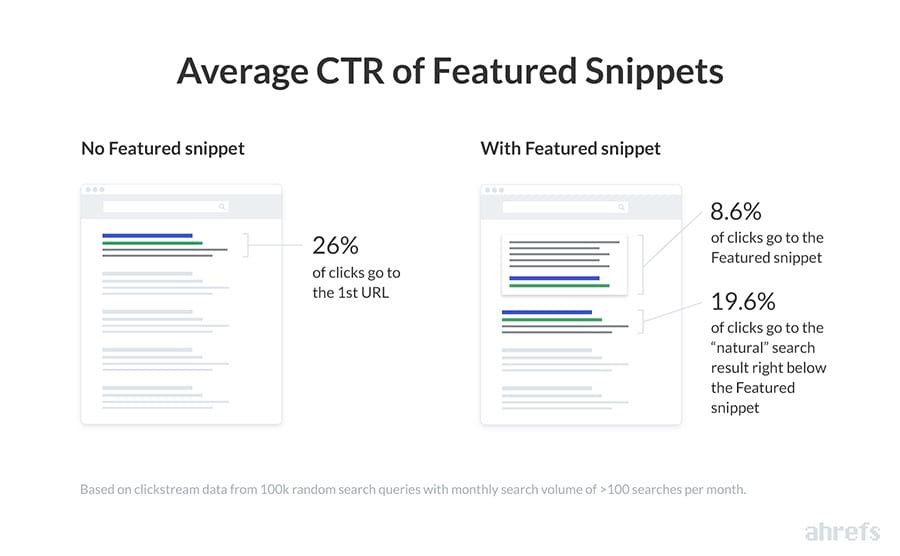
According to a recent study by Ahrefs, featured snippets get about 8.6% of all clicks on the search engine result page.
This may seem low compared to the #1 result, which gets nearly 26% of all search result page clicks. However, how many businesses would give everything to get 8% of all Google clicks in their industry? A lot, right?
Moreover, remember that sometimes the featured snippet comes from web pages that aren’t even ranked on the first result page! It means that you stand to gain massively if you can appear in the featured snippet.
Benefits of Google Featured Snippets
Other advantages of appearing in the Google Featured snippets include;
1. It’s a shortcut to the top organic position
Studies show that over 90% of all featured snippets come from pages that already rank in the top 10 (i.e., the first page). Indeed, nearly 70% of featured snippets come from the top five pages for that search query.
However, the featured snippet takes you to the very top of the results page and is a far easier way to make your way to the top of the search engine results page. You even get a spot above the #1 ranked result while putting in less effort.
2. It’s an excellent branding opportunity
Clicks aside, featured snippets are the first thing users see when the search engine results page is displayed. On mobile devices, they are not only the first on the list but are so prominent that sometimes it’s the only result visible before scrolling.
This is a major advantage for your branding efforts, given that brand-building is the primary driver of long-term growth. The more your brand name appears at the top of search results, the more people see you as a market leader in your industry.
3. Bottom-line benefits
The trickle-down effects of appearing in the featured snippets section are guaranteed to impact your bottom line positively. Since you’re getting more traffic, you’re sure to see an increase in conversions, ultimately leading to more sales.
The credibility and authority that come with appearing in position zero also mean more traffic and an even greater likelihood for sales. As long as you maintain your conversion rate, you’re sure to see more conversion numbers and increase revenue.
Types of Featured Snippets
Generally, snippets fall into three categories, i.e., the paragraph snippet, list (numbered and bullet) snippets, and table snippets, though videos are also popular.
1. Google Snippet Example: Paragraph snippets

Paragraph snippets are the quintessential featured snippet and the result of Google extracting text from a page in an attempt to answer a searcher’s question. They are mostly returned for question queries, i.e., who, what, why, and how.
2. Google Snippet Example: Numbered list snippets
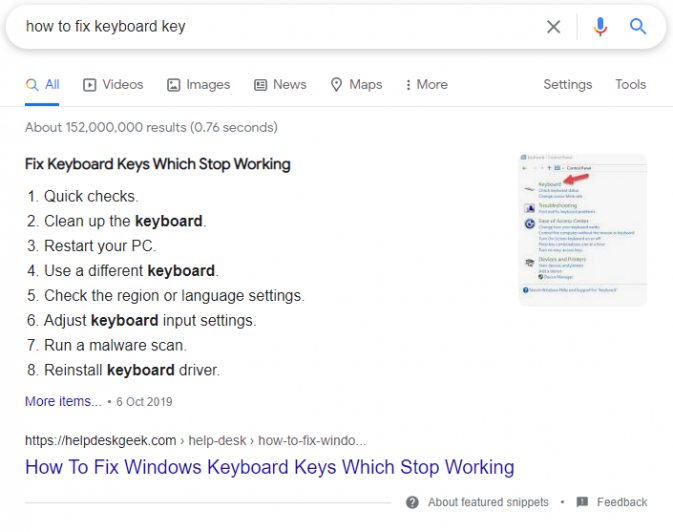
The numbered list snippet is often a box that enumerates steps explaining how to do something, such as recipes, DIY tasks, and how-to queries. They may or may not be accompanied by photos. Whichever the case, users are likely to click through to view the rest of the list.
3. Google Snippet Example: Bullet list snippets
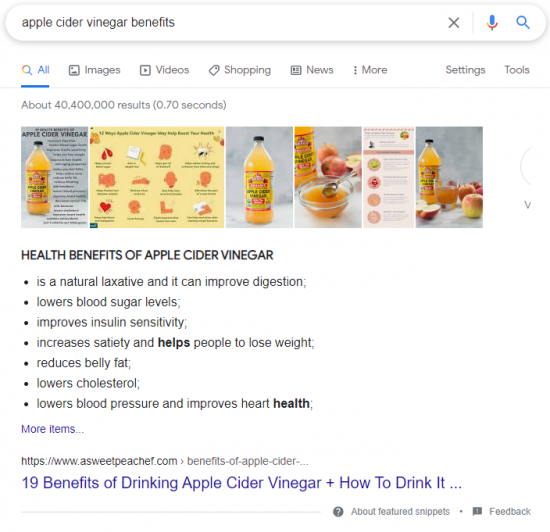
These are still lists, but they are mostly used to enumerate points that don’t need to be arranged in numerical order. Content pieces that typically get featured for bullet lists include product reviews and best-of blog posts.
4. Google Snippet Example: Tables
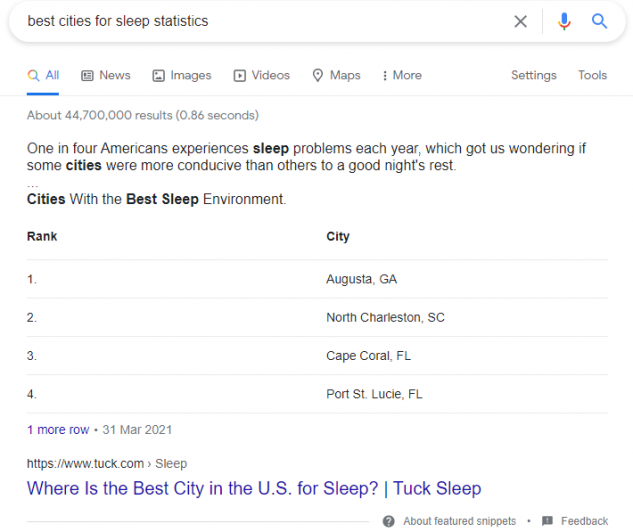
Table snippets currently make up about 29% of all featured snippets. The list will often appear as formatted on the user’s site, though it’s also possible for Google to present the information in a different format. The table can comprise one or more columns, depending on the search query.
5. Google Snippet Example: Video
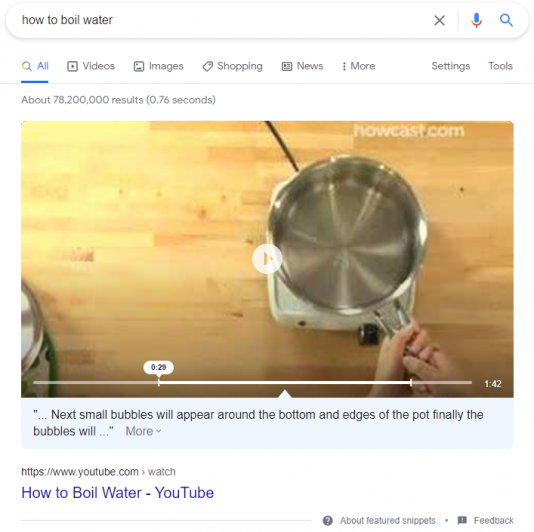
Finally, videos in featured snippets are almost exclusively drawn from YouTube. Google may show the entire clip, a section of the video, or answer the searcher’s question using text from the video.
How to Make your Way to Featured Snippets
Fortunately, you can take several steps to increase your content’s chances of getting featured in the featured snippets box. The following are five quick tips been proven to work;
1. Know Popular Questions and Answer Them
You want to target question-based queries intentionally. The reasoning is that the Google search engine is currently seeking to increase its stickiness by providing answers to popular questions directly inside the search result page.
It explains why the terms “why” (46.91%) and “have” (17.71%) are present in nearly every query earning list snippets, according to a recent Gergich & Co. study (in partnership with MOZ). Meanwhile, “which” at 16.2%, is the top-performing keyword for table snippets. For paragraphs, 95.3% of results are triggered by the word “who,” 87.86% by “what,” and 90.52% by “when.”
You can quickly find question-based keywords to target using the BiQ Keyword Intelligence tool. You will see a list of questions with answers.
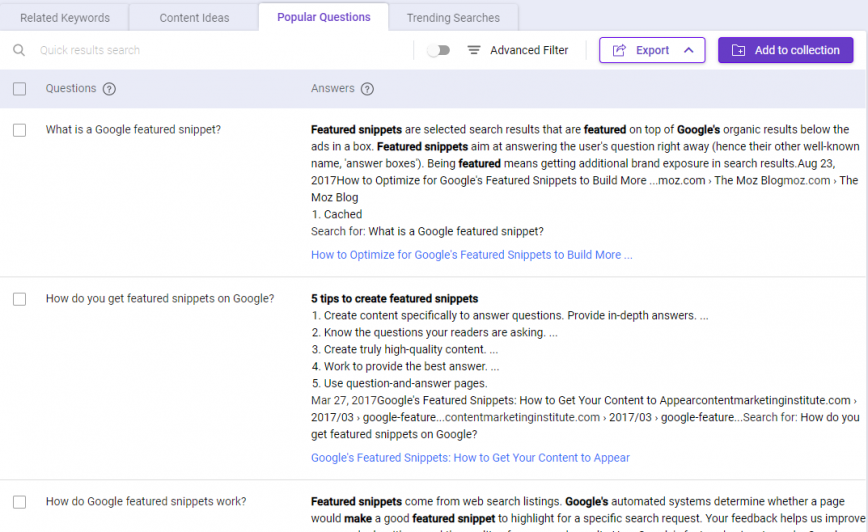
The feature shows questions that are frequently asked by searchers in the search engine.
What you need to do next is to compile a list of questions that are related to your topic and include the answer in your content.
2. Stay within the optimal word count
Today, it’s more important than ever for you to refine your content strategies for today’s sophisticated search engine. It’s always been Google’s goal to deliver the highest quality content to searchers, so creating high-quality content according to these metrics will help your semantic search rankings.
BiQ Content Intelligence has the exact metrics that are catered to boost your visibility. You’ll be able to see them when you switch over to the WordVector toggle and hit the analyze content button.
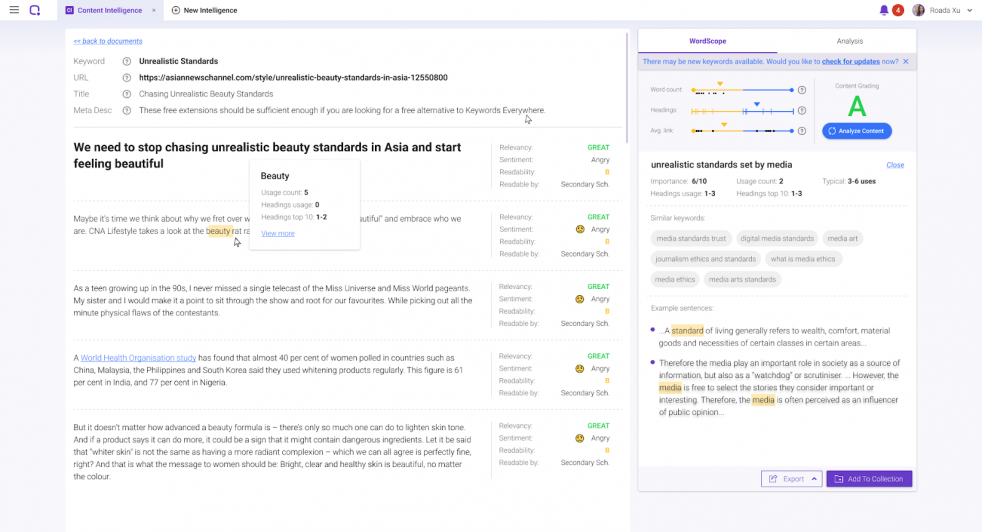
If you stay within the optimal length, you’ll have a higher chance of ranking if you write quality blog posts that could help your organic traffic grow. When your text is not too long nor too short, Google has more clues to determine what your content is about.
Just so you know, the optimal length of a featured snippet paragraph is roughly 40-50 words, equivalent to about 300 characters.
For lists, it’s more about the number of items on the list than word count. Although Google only displays about four list items in the featured snippets section, nearly all featured lists contain at least eight items, prompting Google to display the “More Items” text, leading to increased engagement.
Something else you want to consider is making the list items long enough that Google is forced to truncate them.
Regarding tables, Google displays up to three columns and nine rows. However, for greater engagement, your table needs to be larger so that the search engine also shows the “X additional rows/columns” text.
Word count doesn’t directly apply to video snippets. But, it’s still imperative to keep video descriptions in mind as Google may display some descriptive text alongside the video.
3. Use headers
This is the area a lot of people overlook. Formatting your content correctly using clear and logical headers makes the content easier to skim for your readers and simpler to crawl for Google’s bots. It’s why you should strongly consider using the standard header tags (H1, H2, H3, etc.).
For instance, if writing an article on making an app, the H1 could be something like “How to Make an App (in 7 Steps). Consider marking the steps with header tags too. For instance, you can mark the steps in H2 tags, e.g., <H2> Sketch Your App Idea, <H3> Do a Research, etc. Discuss details within each step under headers H3 and H4.
Well, Google puts more weight on terms that appear in header tags (like an H2). So if a keyword shows up randomly in the middle of a paragraph, that term may or may not be important.

You may use BiQ Content Intelligence to identify the level of importance of the keyword as a header. You may also compare the usage of the keyword with the Top 10 SERP results. If it is highly used then you should know that it must be included in your heading!
4. Add high-quality images and videos
The first thing you need to know here is that Google occasionally shows paragraph/list snippets from one website and image snippets from a completely different user. So, it could display a text snippet from your site and an image snippet from a competitor.
This typically occurs where search engine algorithms determine that although you have the best text answer for the query, your competitor has the better (or only) images.
This affords you room for improvement, given that text snippets are accorded a higher value. If you can supply the right imagery, the search engine will quickly learn about it and display your new images (plus text) for subsequent searches.
A few things to keep in mind when supplying images (videos are another excellent option) for featured snippets include filenames and caption. Ensure to provide very clear and concise filenames that match the image and a caption for every image.
Additionally, always use an ALT attribute to describe the information. The ALT information helps Google’s bots understand your images better. It also provides context. Above all, don’t forget to link the image with an appropriate and descriptive anchor text.
5. Look for existing opportunities
Finally, as we’ve established, any page that ranks in the top 10 in Google search results has the opportunity to feature in the snippets box. You must “fight” for these opportunities. You must be ready to wrestle the featured snippet ranking from your competitors.
When you know your enemy well, you’ll be at a huge advantage. This can be easily done via the Rank Intelligence tool in BiQ.
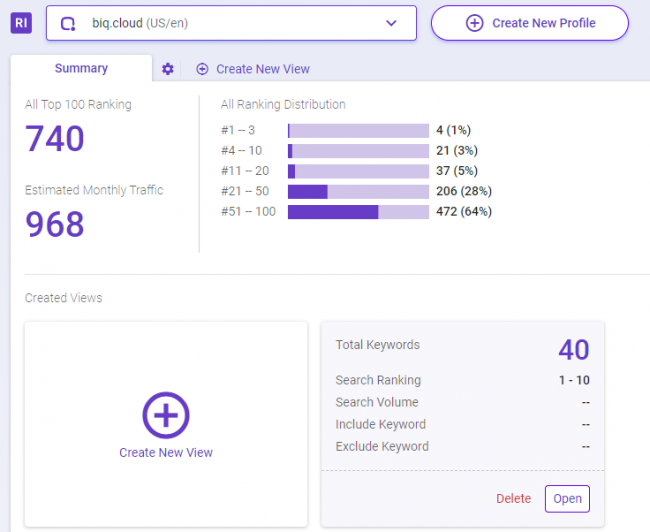
Choose to create a new profile using your competitor’s website URL.
You will then be presented with all the keyword ranking data from your competitor’s site. Set the parameters you want, perhaps you are only looking to steal their keywords that are ranking in the Top 10, and with a search volume of at least 100, so go ahead and set that up and create a view.
As you will see below, you will get a list of results. It shows what keywords your competitors are ranking for so you can create content targeting those same keywords and steal the spot from them.
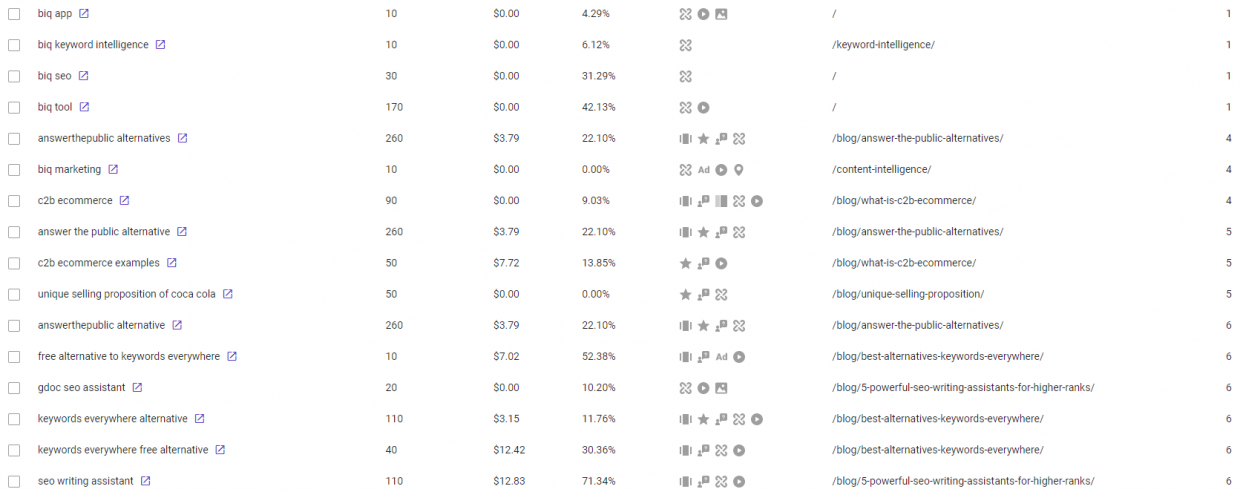
Or, if you are both ranking similarly for the same keyword, now you know where you should work to keep or boost your ranking.

You can also view the SERP features present within the SERP for each of the keywords shown to you. Some of the SERP features include featured snippets, people also ask, related searches, and so on.
Knowing such extensive detail gives you an upper hand in snatching those spots to yourself! So go ahead and make use of Rank Intelligence today.
How to Keep Track of your Featured Snippets
Every business, company, or brand’s goal is to feature in the featured snippets sections not once, not twice, but regularly. For this reason, keeping track of your featured snippet performance and continually seeking opportunities to maintain your status is critical.
As I’ve already introduced above, BiQ Rank intelligence tool is designed purposely for this function.

BiQ’s Rank Intelligence allows you to get quick insights into several aspects of your featured snippet optimization. These include whether the keywords you’ve added to your campaign have featured snippets, existing opportunities to improve your chances to feature, and how many featured snippets your site has (if there are any).
Additionally, you’ll also discover keywords in your SEO campaign that initially appeared in featured snippets at an earlier date but have since lost out to the competition, as well as keywords that have never appeared in featured snippets.
You can use this information to actively improve your SEO campaign as you seek to attain and retain that position #0.
Time to Take the Next Step
Featured snippets are here to stay. They’ve been here since 2013, and it doesn’t look like they’re going away any soon. Indeed, Google seems to be working overtime to improve the featured snippet feature as it holds the key to satisfying people using the search engine.
So, you can’t pretend like it doesn’t exist or matter. This will only disadvantage your SEO while others earn more traffic and close more sales from the same avenue.
Instead, seek ways to fast-track your featured snippets campaign. Improve your content (quality and length), make sure to use headers, invest in quality photography, and always be on the lookout for opportunities to get featured. The benefits are far-reaching.




